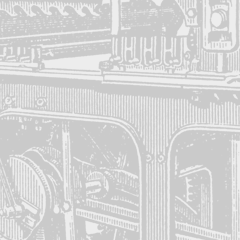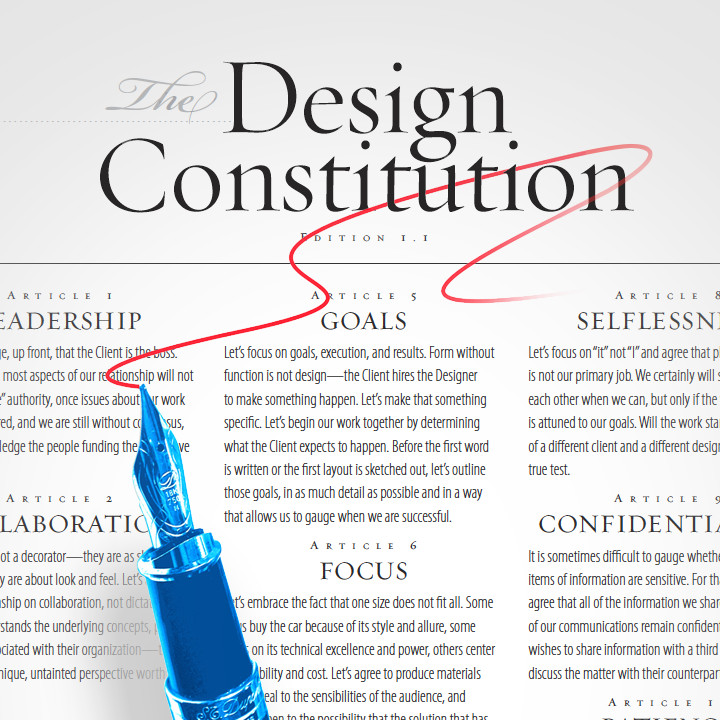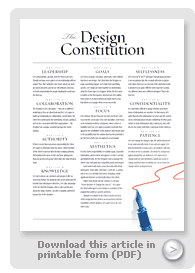What is your understanding of the dynamics of the Client/Creative relationship? I’ve heard lots of opinions and countless complaints, but in all my wanderings, I have yet to find a good, non-legalese consensus of what we should expect of each other. A proposition that lays out the “spirit” of our relationship.
Why concern yourself with it? Because, if you’re human (like me), you sometimes repeat the same mistakes. You assume that your counterparts understand what you understand until the inevitable problems arise and you kick yourself. You think about how much easier it would have been had we simply agreed to some ground rules to begin with.
You are invited to join me in drafting “The Design Constitution:” a document that lays out the basics of interaction between Creative (designer, copywriter, photographer, illustrator, and so on) and Client. Sound easy? Not for me—just getting the first fourteen articles in writing has been cause for lots of thought and more than a little soul-searching.

Have a look. Just below the last article is a form for contributing your thoughts and ideas. I will post pertinent comments and make edits as we go.
![]()
Let’s acknowledge, up front, that the Client is the boss. Though we hope most aspects of our relationship will not require “boss-like” authority, once issues about our work are raised and aired, and we are still without consensus, we both acknowledge the people funding the work have the final say.
![]()
The Designer is not a decorator—they are as skilled at marketing as they are about look and feel. Let’s agree to build our relationship on collaboration, not dictation. The Client best understands the underlying concepts, products, and services associated with their organization—the Designer has a unique, untainted perspective worth sharing.
![]()
If there is more than one person representing the Client, let’s agree to determine from the outset, which member of the Client’s team has final decision-making authority. Particularly in the areas of style and tone, giving more than one person veto power often takes the edge off great work.
![]()
Let’s get to know our customers and prospects like we never have before: the problems they need solved and the benefits that will improve their lives. Let’s take advantage of the fact that the Designer, who is often uneducated about the subject matter, can offer a valuable unfettered perspective of the situation.
![]()
Let’s focus on goals, execution, and results. Form without function is not design—the Client hires the Designer to make something happen. Let’s make that something specific. Let’s begin our work together by determining what the Client expects to happen. Before the first word is written or the first layout is sketched out, let’s outline those goals, in as much detail as possible and in a way that allows us to gauge when we are successful.
![]()
Let’s embrace the fact that one size does not fit all. Some of us buy the car because of its style and allure, some focus on its technical excellence and power, others center on reliability and cost. Let’s agree to produce materials that appeal to the sensibilities of the audience and remain open to the possibility that the solution that has the potential to get the best results may not appeal to us personally.
![]()
It is the Client’s responsibility to establish goals, to provide information, and to review and approve or reject concepts and finished work. It is the Designer’s job to translate the client’s story and goals into compelling words and images.
Great work results from a near obsession with detail and nuance. Done right, a brochure, a Web site, a catalog, and so on, is so carefully structured, changing a single significant element can drastically impact the whole.
Rather than dictate specific changes to a design—“move this here” or “change the color to,”—let’s agree the Client will request a new design or a variation of the original that addresses specific problems.
Though it is helpful for the Client to point out areas of the design that they believe are inconsistent with the sensibilities of their audience, let’s agree not to do each other’s jobs.
![]()
Let’s focus on “it” not “I” and agree that pleasing ourselves is not our primary job. We certainly will strive to please each other when we can, but only if the work that results is attuned to our goals. Will the work stand the scrutiny of a different client and a different designer? That is the true test.
![]()
It is sometimes difficult to gauge whether and which items of information are sensitive. For that reason, let’s agree that all of the information we share and the content of our communications remain confidential. If either party wishes to share information with a third party, they will discuss the matter with their counterpart before doing so.
![]()
Let’s not change for change’s sake. We will be immersed in our work and will review it over and over again. Let’s keep in mind that, in many cases, our audience will only see what we do occasionally. Our desire for change may appear long before our audience’s. Let’s agree not to change until we have identified a significant reason to change and have done everything we can to ensure the change will be an improvement.
![]()
Real rewards are the result of ideas, products, and services that make the world a better place. Let’s agree to maintain the highest standard of ethics by dedicating ourselves to honesty, clarity, and style.
![]()
Let’s trust each other. We team up because there are some things the Client knows more about than the Designer and vice-versa. When there is no compelling reason to take a particular fork in the road, let’s concede the decision to the person with the most experience.
![]()
Let’s agree how we will mediate disputes. Every relationship, especially one that entails so much communication and so many details, will inevitably suffer problems. Let’s agree to address issues freely and to allow space for each other to correct mistakes. If an impasse arises, let’s agree to share it with each other first, and if necessary, to choose a mutually acceptable mediator.
![]()
Because the Client has final decision-making power, let’s agree that the Client accepts ultimate responsibility for the correctness of content. It is the job of the Designer, Writer, and Proofreader to produce materials that are as accurate as possible; however, it is the sole responsibility of the Client to approve all aspects of the final work before it is published.
![]()
A Client who invests resources, time, and money in educating the Designer about their industry, audience, and organization deserves loyalty. A Designer who invests the same resources, time, and money in learning deserves the same loyalty. Unless otherwise agreed to, let’s define loyalty as being honest and sincere with one’s partner, not speaking poorly of them to others, and not working with direct competitors.
When changes in the relationship are unavoidable, let’s agree to share the reasons for the change and to give each other as much notice as possible before the change is made.
Your turn to share your thoughts
To share you thoughts, please use the Contact page. Is a “constitution” useful or pie-in-the-sky? What have I left out? How would you respond, as a client, receiving such a document? How would you, as a designer, feel about sharing it with a client?
Thanks to my colleague Daniel Will-Harris who offered some excellent insights as I put my thoughts in writing. You can read a related article he wrote titled “How to (and not to) work with a designer” > Here <
<
h3>Feedback from readers
From STEVE: I have had clients read (another designer’s rendition of this type of document). It all sounds good to a designer but how does it sound to the people paying? Frankly, they don’t like it. It sounds like the designer is telling them what to do and trying to make a power play. So the piece needs to be toned down and edited. The attitude presented can alienate. > Steve
Chuck’s REPLY: I understand Steve—that’s why I call this an experiment. As with anything else, there are no universal answers to such complex questions. What you give to whom is based on the assessments of those on the scene. I wish we all (client and provider) understood these basics without being told—and I readily admit, I am hesitant myself about how and when to address these issues.
From UNNAMED: Have you examined Graphic Artists Guild Pricing and Ethical Guidelines? It level sets everyone’s expectations by providing detailed descriptions of the roles and responsibilities of the client and the designer. It also covers ownership, usage rights, and a wealth of other topics which often plague inexperienced buyers or designers (or, heaven forbid, both).
Chuck’s REPLY: Absolutely, I actually sell the Guidelines book in the ideabook.com store. But I’ve always thought of it as a tool for the provider—a source of information, pricing, and such. The contracts and specifics are a little too tough-minded for me.
From MATT: Nice idea – but not really workable. Clients only buy this kind of thing in the early stages of a relationship, when they’re feeling all warm and fluffy about you and the great work you’re going to do that’s going to make them look good. When the deadlines start looming and they’re getting grief from their boss, high-minded notions of mutual respect and partnership fly out of the window.
In my experience, the only thing that’s effective in making the client-agency relationship work better is to explain it in performance/economic terms. Their account is ust one of the accounts on which the agency works. Hence, they are much more likely to get your best work – and the involvement of your best people – if their account is good to work on and profitable.
I’ve found that clients appreciate the honesty and logic of this explanation – and, in most cases, become far more effective to work with (and produce better work for) as a result. It’s human nature: tell them you do your best work for your best clients and they will want to be your best client. Either that, of they’ll take their account to an agency they’ll be able to bully (in which case, they’re not the kind of client you want anyway).
Chuck’s REPLY: Interesting approach Matt. You obviously speak from a position of strength. My point is that even if this all goes out the window, you at least have something to point back to if things get out of hand.
From BERNIE: …We use freelance designers to help us with our wide array of clientele.
We were just discussing this morning what we can expect from designers and vice versa. Some will do multiple changes and not bill extra. Others have a set amount of modifications, then “close and bill” the job – charging more as more changes arise.
Some designers are quite close to their work and we have had heated discussions with them as we try to rein them in and stick with the plan. I do admit that we do listen to their advice as well and our clients seem to like what they do.
We use about 4-5 designers at any time. All are different personalities and all have their own specialty.
Since there is no “industry norm” as you point out in your last briefing, we have to be able to talk to each one in a different manner to get maximum benefits.
I fully realize that the client has to understand as well what a designer can expect from us. This is the only way to have an effective relationship.
Chuck’s REPLY: Yup, creatives need to remember we can be an eclectic bunch. Clients must deal with the dramatic differences between providers and their business practices and corporate personalities. No small feat.




